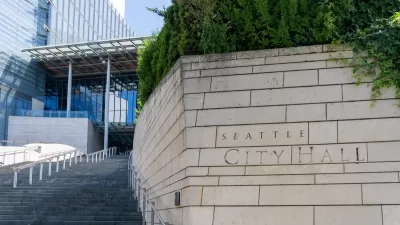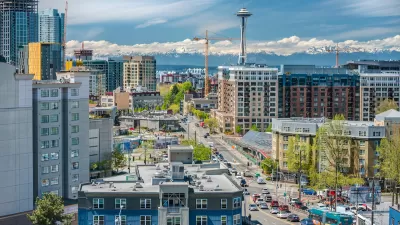Developers in Seattle have been building ultra-compact apartments to provide alternatives to high housing prices. But these "aPodments," which take advantage of loopholes in codes, could bring negative consequences with the large increase in density.
In the Emerald City, dozens of microhousing units are being built on what were once single-family lots. This increasingly common kind of housing "offers a way to reconcile rising urban housing prices with a financially struggling generation's preference for city living," says Claire Thompson, and "is now prompting passionate debate over the best approach to urban landfill." Such developments are a creative way of building affordable housing, but face opposition from "wealthy homeowners who don't want younger, poorer folks flooding their neighborhood, competing for parking spaces, blocking their views, destroying local character, and depreciating neighboring property values."
Another problem, says critics, "is not the idea of density itself or the types of new neighbors it could bring, but the backhanded way Seattle developers have gone about capitalizing on the trend." San Francisco has updated its city code to allow small units and New York is piloting "micro-apartment" projects, but Seattle is allowing developers to count multiple microapartments as one large unit and bypass standard design and environmental reviews. "If aPodments start showing up on every block," said Carl Winter, a representative of neighborhood group Reasonable Density Seattle, "that's an incredible increase in density, and they're never going to study what that density would do."
The Capitol Hill Community Council submitted a resolution to the Seattle City Council asking for a moratorium on new microapartments until the design-review loophole is closed, says Thompson, but it doesn't sound like the city is seriously considering it. "We're observing them and intend to do a little more study," said Mike Podowski, land use policy manager for the city's Department of Planning and Development.
FULL STORY: Peace in a pod: How tiny apartments could reshape the big city

Alabama: Trump Terminates Settlements for Black Communities Harmed By Raw Sewage
Trump deemed the landmark civil rights agreement “illegal DEI and environmental justice policy.”

Planetizen Federal Action Tracker
A weekly monitor of how Trump’s orders and actions are impacting planners and planning in America.

The 120 Year Old Tiny Home Villages That Sheltered San Francisco’s Earthquake Refugees
More than a century ago, San Francisco mobilized to house thousands of residents displaced by the 1906 earthquake. Could their strategy offer a model for the present?

Indy Neighborhood Group Builds Temporary Multi-Use Path
Community members, aided in part by funding from the city, repurposed a vehicle lane to create a protected bike and pedestrian path for the summer season.

Congestion Pricing Drops Holland Tunnel Delays by 65 Percent
New York City’s contentious tolling program has yielded improved traffic and roughly $100 million in revenue for the MTA.

In Both Crashes and Crime, Public Transportation is Far Safer than Driving
Contrary to popular assumptions, public transportation has far lower crash and crime rates than automobile travel. For safer communities, improve and encourage transit travel.
Urban Design for Planners 1: Software Tools
This six-course series explores essential urban design concepts using open source software and equips planners with the tools they need to participate fully in the urban design process.
Planning for Universal Design
Learn the tools for implementing Universal Design in planning regulations.
Clanton & Associates, Inc.
Jessamine County Fiscal Court
Institute for Housing and Urban Development Studies (IHS)
City of Grandview
Harvard GSD Executive Education
Toledo-Lucas County Plan Commissions
Salt Lake City
NYU Wagner Graduate School of Public Service





























